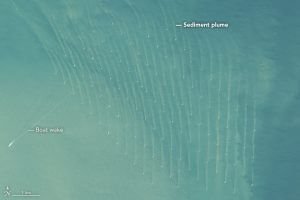Award-winning technology holds key to NASA’s discovery of sediment flumes
Huge brown masses of suspended sediment that could threaten marine life and habitats were highlighted on the newly-released images from space of North Sea wind farms by NASA’s Operational Land Imager (OLI). Scour Prevention Systems Ltd’s mats, made from end-of-life car tyres fixed together, are designed to catch and retain suspended sediment, reducing the problem and stabilising the seabed.
The placement of tyres flat on the seabed is key to their ability to entrap sediment within their centres. The trapped sediment gives the mats a self-stabilising function and prevents the lowering of the seabed by scouring. High energy flows transport sediment across scour prone sites, and especially within offshore windfarms. As they pass across the mat surface, these flows are disturbed and their speed reduces. As a result, sediment transport across the mats is disrupted and the sediment is entrapped within the mat’s void spaces, where it is retained due to the tyre’s shape.
The tyre-mattress solution remains the only current solution on the market to this growing problem caused by tidal current moving around turbine foundations. Whilst technologically simple, it is internationally protected by a range of patents. NASA’s detailed views of images of some of the North Sea’s largest wind farms – Greater Gabbard, London Array, and Thanet – clearly show light brown plumes of suspended sediments extending from each turbine foundation.

Sediment plumes pictured at Thanet offshore wind farm in the SNS [Source: http://earthobservatory.nasa.gov/IOTD/view.php?id=89063&src=eorss-iotd]
Wind turbines have shown up as white dots in images from space for the last decade – but this is the first time sediment plumes have featured.
John Balch, chairman of Lowestoft-based SPSL, said the new images had prompted the company to invest in research on the effectiveness of its product to tackle the issue clearly shown by the satellite images. This is an important piece of research from NASA showing something that has never been seen before in this kind of detailed resolution, and we are acting on it immediately. This significant increase in suspended sediments in the water column left unchecked could have devastating impacts on marine life, reducing visibility that could impact the growth of aquaculture and affect migratory species.
“The technology of our tyre mats offer a practicable solution to North Sea sediment plumes and the only solution to capture suspended sediment, remediating sites where there is known scour and preventing the onset of future scouring. We know that there is a major pipeline of new offshore developments across the North Sea, and if we identify these plumes now with a handful of wind farms, solutions can be put in place to solve the problem or counteract the effects going forward in the fast-moving industry.”
The SPSL tyre-mattress solution has been proven through extensive testing and in-field demonstrations with considerable ecological benefits as the tyres are environmentally inert when submerged, have a low carbon footprint and are completely recycled. It is not fully clear how increased suspended sediment could affect the relatively shallow underwater environment, which is known to be an important fish nursery, NASA said.
Two years ago, researchers analysed satellite imagery and found that wakes and plumes could measure anywhere from 30 to 150 meters wide and up to several kilometers long. Quinten Vanhellemont, a researcher at the Royal Belgian Institute of Natural Sciences and lead author of the 2014 research paper, said: “The fact that the wakes are browner than the surrounding waters shows that they contain more suspended sediments. This shows that the installation of the wind turbines not only modifies the wind field above the sea surface (which is expected as they are extracting wind energy), but that they also modify the currents and sediment transport in the water.”
- Source:
- Scour Prevention
- Link:
- www.scourprevention.com/...
- Keywords:
- Scour Prevention, NASA, sediments



